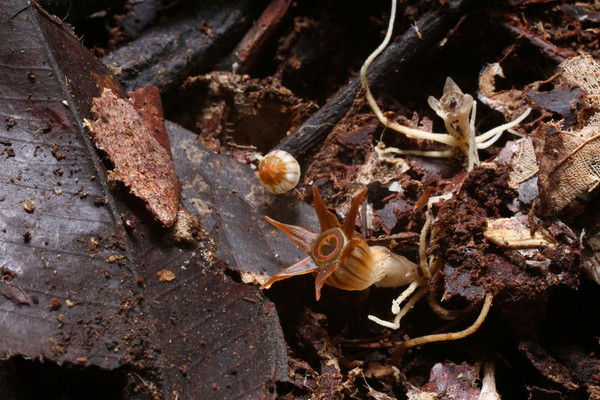Scientists from the UP Faculty of Science have scored again and discovered another plant of the Thismia genus in Brunei on the island of Borneo. Thismia inconspicua was found by the ecologists in a rainforest in early 2015. This makes it the third discovered species of a genus which was not known to exist on Borneo before the scientific expeditions from Olomouc arrived. The Olomouc ecologists have dubbed it “hvězdnatka” in Czech: “starplant”.
Experts from the Department of Ecology and Environmental Sciences have been conducting expeditions to the tropical rainforests of Borneo for years. Their first “catch” was Thismia hexagona, followed by Thismia brunneomitra with a flower reminiscent of a bishop’s mitre. The third rare species is a Thismia which was attributed inconspicua, inconspicuous. The discovery of all three star-shaped plants was made by the botanist Michal Sochor, who literally risked life and limb during his research this time.
Plants wiped out by a branch
“I was searching an area where the research has been going on for years. I noticed a tiny non-green plant, an obvious representative of the Thismia genus. Since I have only found specimens that were out of bloom, we had no certainty that this was a new species. So I came back in two days and found a specimen in bloom. The discovery became clearer,” said Sochor who was almost hit by a falling branch during mapping the place of discovery. “It was quite dramatic. The branch was perhaps seven metres long. It wiped out a portion of the plants,” recalled Sochor.
After subsequent comparison with existing items in the herbarium and the literature, Olomouc scientists could claim with certainty that they are in possession of a new species. These tiny non-green plants live in symbiosis with mushrooms. The whole plant is only a few centimetres long, with no leaves; its brown flower is barely visible in the surrounding layer of rotting foliage. “The flower is bulb-shaped, as in other Thismia species. It is a sort of hollow space with star-shaped lips around the entrance. The specialty of this species is the minuscule size of the tentacles at the end of the lips. Another peculiarity which makes it different from all known Thismia is the bent, distorted shape of the flower tube. This was one of the markers that helped us to identify this plant as a new species,” said another member of the expedition, Martin Dančák.
Scientists’ lucky stars
The newly-discovered species proves that Thismia are more common in the Brunei rainforests than was anticipated. Olomouc scientists have been fortunate also because of the fact that they always visit the island during the time of year when Thismia can be observed. The only found specimen of Thismia inconspicua in bloom remained in the Brunei National Herbarium and Resource Conservation Centre. Only a few overblown specimens were transported to Olomouc.
There are about 60 species of Thismia in the world, mostly in Southeast Asia’s and South America’s tropical rainforests. All three species discovered by Olomouc botanists are, similarly to the majority of species of Thismia genus, steno-endemic – they occur only in one spot in the world.
